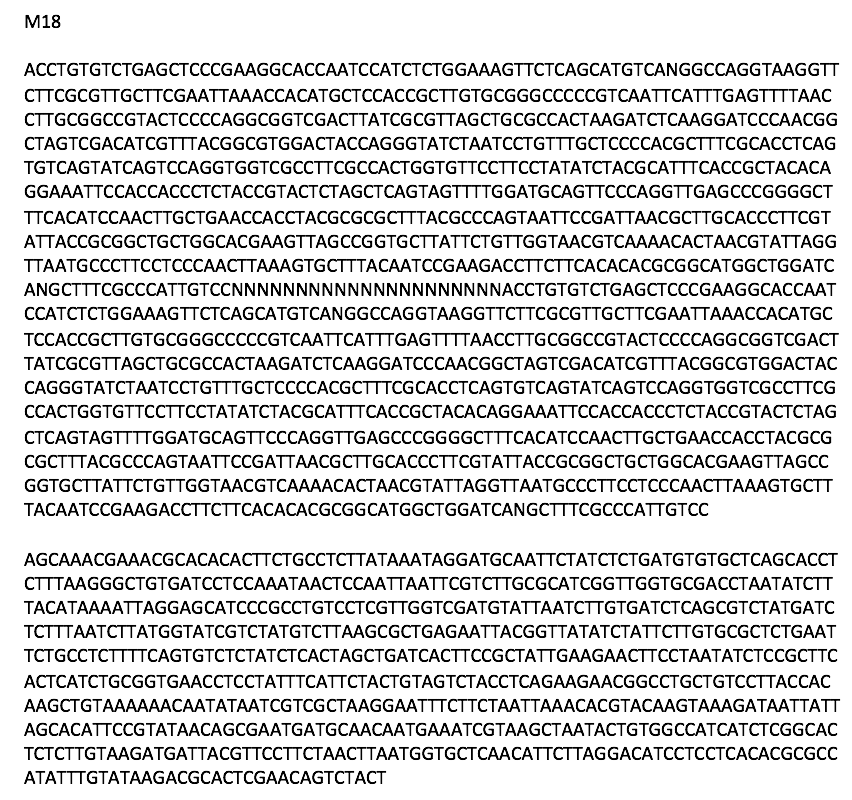Genus S and J: Difference between revisions
No edit summary |
No edit summary |
||
| Line 4: | Line 4: | ||
==Classification== | ==Classification== | ||
<p>Kingdom: Bacteria | <p>Kingdom: Bacteria | ||
<p>Phylum: Proteobacteria | <p>Phylum: Proteobacteria | ||
| Line 11: | Line 10: | ||
<p>Family: Pseudomonadaceae | <p>Family: Pseudomonadaceae | ||
<p>Genus: Pseudomonas | <p>Genus: Pseudomonas | ||
<p>Species: <b><i> P. aeruginosa</i></b> | <p>Species: <b><i> P. aeruginosa</i></b></p> | ||
===Species=== | ===Species=== | ||
{| | {| | ||
| height="10" bgcolor="#FFDF95" | | | height="10" bgcolor="#FFDF95" | | ||
| Line 22: | Line 20: | ||
''Pseudomonas aeruginosa'' | ''Pseudomonas aeruginosa'' | ||
<p>Taxonomy ID: 1454219</p> | |||
Taxonomy ID: 1454219 | <p>Inherited blast name: g-proteobacteria</p> | ||
Inherited blast name: g-proteobacteria | |||
==Habitat Information == | ==Habitat Information == | ||
The soil was obtained on September 8, 2016 during a clear night. I browsed the area of my apartment complex around 8:30 PM and came across a grassy area near one of the pools right behind my unit. | |||
<p>Map Unit Name: Tarrant and Speck soils, 0 to 2 percent slopes</p> | |||
==Genome Structure== | ==Genome Structure== | ||
| Line 34: | Line 32: | ||
<b> | <b> | ||
This organism has one circular chromosome and divides by binary fission. We identified the organism using PCR and gene sequencing of its rRNA genes below. <br> | This organism has one circular chromosome and divides by binary fission. We identified the organism using PCR and gene sequencing of its rRNA genes below. <br> | ||
[[File:Screen Shot 2016-12-03 at 12.36.23 PM.png|frame|center|float|400x420px|First PCR sequencing]] | |||
[[File:Screen Shot 2016-12-03 at 12.37.20 PM.png|frame|center|float|400x420px|Second PCR sequencing]]</p> | |||
<br> M17 | <br> M17 | ||
| Line 50: | Line 51: | ||
<b> <br> | <b> <br> | ||
==Cell Structure, Metabolism and Life Cycle== | ===Cell Structure, Metabolism and Life Cycle=== | ||
Interesting features of cell structure; how it gains energy; what important molecules it produces. | Interesting features of cell structure; how it gains energy; what important molecules it produces. | ||
| Line 67: | Line 68: | ||
<ul> ...can be treated with aminoglycosides and penicillins. Prompt attention is vital.</ul> | <ul> ...can be treated with aminoglycosides and penicillins. Prompt attention is vital.</ul> | ||
==References== | ===References=== | ||
[Sample reference] [https://www.ncbi.nlm.nih.gov/pubmed/6405475 Bodey GP, Bolivar R, Fainstein V, Jadeja L. "'Infections caused by Pseudomonas aeruginosa'". ''Reviews of Infectious Diseases''. 1983. Volume 5. p. 279-313.] | [Sample reference] [https://www.ncbi.nlm.nih.gov/pubmed/6405475 Bodey GP, Bolivar R, Fainstein V, Jadeja L. "'Infections caused by Pseudomonas aeruginosa'". ''Reviews of Infectious Diseases''. 1983. Volume 5. p. 279-313.] | ||
==Author== | ===Author=== | ||
Page authored by Stephanie N. and Jessica G., students of Prof. Kristine Hollingsworth at Austin Community College. | Page authored by Stephanie N. and Jessica G., students of Prof. Kristine Hollingsworth at Austin Community College. | ||
<!-- Do not remove this line-->[[Category:Pages edited by students of Kristine Hollingsworth at Austin Community College]] | <!-- Do not remove this line-->[[Category:Pages edited by students of Kristine Hollingsworth at Austin Community College]] | ||
Revision as of 18:54, 3 December 2016
Classification
Kingdom: Bacteria
Phylum: Proteobacteria
Class: Gammaproteobacteria
Order: Pseudomonadales
Family: Pseudomonadaceae
Genus: Pseudomonas
Species: P. aeruginosa
Species
|
NCBI: Taxonomy |
Pseudomonas aeruginosa
Taxonomy ID: 1454219
Inherited blast name: g-proteobacteria
Habitat Information
The soil was obtained on September 8, 2016 during a clear night. I browsed the area of my apartment complex around 8:30 PM and came across a grassy area near one of the pools right behind my unit.
Map Unit Name: Tarrant and Speck soils, 0 to 2 percent slopes
Genome Structure
Describe the size and content of the genome. How many chromosomes? Circular or linear? Other interesting features? What is known about its sequence? Include S Ribosomal sequence that you obtained from PCR and sequencing here.
This organism has one circular chromosome and divides by binary fission. We identified the organism using PCR and gene sequencing of its rRNA genes below.
M17
GGGNNNNNNNNNTNNGNNNNTGGNNNNNNNTTNNNNNGATCCAGCCATGCCGCGTGTGTGAAGAAGGTCTTCGGNTNNTANAAGCACTTTAAGTTGGGAGGAAGGGCATTAACCTAATACGTTAGTGTTTTGACGTTACCAACAGAATAAGCACCGGCTAACTTCGTGCCAGCAGCCGCGGTAATACGAAGGGTGCAAGCGTTAATCGGAATTACTGGGCGTAAAGCGCGCGTAGGTGGTTCAGCAAGTTGGATGTGAAAGCCCCGGGCTCAACCTGGGAACTGCATCCAAAACTACTGAGCTAGAGTACGGTAGAGGGTGGTGGAATTTCCTGTGTAGCGGTGAAATGCGTAGATATAGGAAGGAACACCAGTGGCGAAGGCGACCACCTGGACTGATACTGACACTGAGGTGCGAAAGCGTGGGGAGCAAACAGGATTAGATACCCTGGTAGTCCACGCCGTAAACGATGTCGACTAGCCGTTGGGATCCTTGAGATCTTAGTGGCGCAGCTAACGCGATAAGTCGACCGCCTGGGGAGTACGGCCGCAAGGTTAAAACTCAAATGAATTGACGGGGGCCCGCACAAGCGGTGGAGCATGTGGTTTAATTCGAAGCAACGCGAAGAACCTTACCTGGCCTTGACATGCTGAGAACTTTCCAGAGATGGATTGGTGCCTTCGGGANCTCAGACACAGGNNNNNNNNNGGGNNNNNNNNNTNNGNNNNTGGNNNNNNNTTNNNNNGATCCAGCCATGCCGCGTGTGTGAAGAAGGTCTTCGGNTNNTANAAGCACTTTAAGTTGGGAGGAAGGGCATTAACCTAATACGTTAGTGTTTTGACGTTACCAACAGAATAAGCACCGGCTAACTTCGTGCCAGCAGCCGCGGTAATACGAAGGGTGCAAGCGTTAATCGGAATTACTGGGCGTAAAGCGCGCGTAGGTGGTTCAGCAAGTTGGATGTGAAAGCCCCGGGCTCAACCTGGGAACTGCATCCAAAACTACTGAGCTAGAGTACGGTAGAGGGTGGTGGAATTTCCTGTGTAGCGGTGAAATGCGTAGATATAGGAAGGAACACCAGTGGCGAAGGCGACCACCTGGACTGATACTGACACTGAGGTGCGAAAGCGTGGGGAGCAAACAGGATTAGATACCCTGGTAGTCCACGCCGTAAACGATGTCGACTAGCCGTTGGGATCCTTGAGATCTTAGTGGCGCAGCTAACGCGATAAGTCGACCGCCTGGGGAGTACGGCCGCAAGGTTAAAACTCAAATGAATTGACGGGGGCCCGCACAAGCGGTGGAGCATGTGGTTTAATTCGAAGCAACGCGAAGAACCTTACCTGGCCTTGACATGCTGAGAACTTTCCAGAGATGGATTGGTGCCTTCGGGANCTCAGACACAGG
GCAGACCCAATCAACCCGCTAGAAGAAAGTAGGCGCCAAATACAGTTCTACAGACGTGGCGCGTGTGTGGAGGATCTCCTCTTAATGGAGGCTCTCGATGTCGAAAGAATGATCATAACTTTCCTCTTTGAGTGTGCGGACGAAACAACCAGAGTATGCTCTTTTTATTTCCTTGCTAGCAGCTTCGATAGTACGAGGAATGCATGCGTAATTCGTAGTGACTGAACGTATTGCGCGCGTAGAAGAACCAGCAGGTGGAATGAGACCCCTTTGCCCTCATCTTGACATCTGCATCTTGTTCTACTGAGCTAGAGTACGCTGGAGATTGATGCATTCCCTTGTGAAGCGATGATTTGCGTATATATAGAAGGAATCTTTTGTGTCTAGGCCGACTTCTTGAACTGATACTGACTTTGAGATGCGAGGGCGTGAAAATAAGTTTGAATAAGTTCCTTTGAAAGTCTTCAATTAACCCAATGCCGATTAGCTTTGGAAATATTAGAGATATCAGAGAAGCAGCTATGTAGAGATGTCTACAGCTTGAAAAGAACAACTTCACGATGATCTTTCACTTAATTAGACGCTCCCGTGCGCACGAGCTGTAGAATATGTTGAATTACTAGGAACCGCGAGGAGCATCACATGCCGTCGTCATATTGAGAGCTCCCTACAGATAAATAGATGCGTCCTCAAGATCACACACACATG
M18
ACCTGTGTCTGAGCTCCCGAAGGCACCAATCCATCTCTGGAAAGTTCTCAGCATGTCANGGCCAGGTAAGGTTCTTCGCGTTGCTTCGAATTAAACCACATGCTCCACCGCTTGTGCGGGCCCCCGTCAATTCATTTGAGTTTTAACCTTGCGGCCGTACTCCCCAGGCGGTCGACTTATCGCGTTAGCTGCGCCACTAAGATCTCAAGGATCCCAACGGCTAGTCGACATCGTTTACGGCGTGGACTACCAGGGTATCTAATCCTGTTTGCTCCCCACGCTTTCGCACCTCAGTGTCAGTATCAGTCCAGGTGGTCGCCTTCGCCACTGGTGTTCCTTCCTATATCTACGCATTTCACCGCTACACAGGAAATTCCACCACCCTCTACCGTACTCTAGCTCAGTAGTTTTGGATGCAGTTCCCAGGTTGAGCCCGGGGCTTTCACATCCAACTTGCTGAACCACCTACGCGCGCTTTACGCCCAGTAATTCCGATTAACGCTTGCACCCTTCGTATTACCGCGGCTGCTGGCACGAAGTTAGCCGGTGCTTATTCTGTTGGTAACGTCAAAACACTAACGTATTAGGTTAATGCCCTTCCTCCCAACTTAAAGTGCTTTACAATCCGAAGACCTTCTTCACACACGCGGCATGGCTGGATCANGCTTTCGCCCATTGTCCNNNNNNNNNNNNNNNNNNNNNACCTGTGTCTGAGCTCCCGAAGGCACCAATCCATCTCTGGAAAGTTCTCAGCATGTCANGGCCAGGTAAGGTTCTTCGCGTTGCTTCGAATTAAACCACATGCTCCACCGCTTGTGCGGGCCCCCGTCAATTCATTTGAGTTTTAACCTTGCGGCCGTACTCCCCAGGCGGTCGACTTATCGCGTTAGCTGCGCCACTAAGATCTCAAGGATCCCAACGGCTAGTCGACATCGTTTACGGCGTGGACTACCAGGGTATCTAATCCTGTTTGCTCCCCACGCTTTCGCACCTCAGTGTCAGTATCAGTCCAGGTGGTCGCCTTCGCCACTGGTGTTCCTTCCTATATCTACGCATTTCACCGCTACACAGGAAATTCCACCACCCTCTACCGTACTCTAGCTCAGTAGTTTTGGATGCAGTTCCCAGGTTGAGCCCGGGGCTTTCACATCCAACTTGCTGAACCACCTACGCGCGCTTTACGCCCAGTAATTCCGATTAACGCTTGCACCCTTCGTATTACCGCGGCTGCTGGCACGAAGTTAGCCGGTGCTTATTCTGTTGGTAACGTCAAAACACTAACGTATTAGGTTAATGCCCTTCCTCCCAACTTAAAGTGCTTTACAATCCGAAGACCTTCTTCACACACGCGGCATGGCTGGATCANGCTTTCGCCCATTGTCC
AGCAAACGAAACGCACACACTTCTGCCTCTTATAAATAGGATGCAATTCTATCTCTGATGTGTGCTCAGCACCTCTTTAAGGGCTGTGATCCTCCAAATAACTCCAATTAATTCGTCTTGCGCATCGGTTGGTGCGACCTAATATCTTTACATAAAATTAGGAGCATCCCGCCTGTCCTCGTTGGTCGATGTATTAATCTTGTGATCTCAGCGTCTATGATCTCTTTAATCTTATGGTATCGTCTATGTCTTAAGCGCTGAGAATTACGGTTATATCTATTCTTGTGCGCTCTGAATTCTGCCTCTTTTCAGTGTCTCTATCTCACTAGCTGATCACTTCCGCTATTGAAGAACTTCCTAATATCTCCGCTTCACTCATCTGCGGTGAACCTCCTATTTCATTCTACTGTAGTCTACCTCAGAAGAACGGCCTGCTGTCCTTACCACAAGCTGTAAAAAACAATATAATCGTCGCTAAGGAATTTCTTCTAATTAAACACGTACAAGTAAAGATAATTATTAGCACATTCCGTATAACAGCGAATGATGCAACAATGAAATCGTAAGCTAATACTGTGGCCATCATCTCGGCACTCTCTTGTAAGATGATTACGTTCCTTCTAACTTAATGGTGCTCAACATTCTTAGGACATCCTCCTCACACGCGCCATATTTGTATAAGACGCACTCGAACAGTCTACT
Cell Structure, Metabolism and Life Cycle
Interesting features of cell structure; how it gains energy; what important molecules it produces.
This microorganism is bacillus (rod shaped) and its colonial morphology is small, entire, convex, mucoid, and an opaque/tan color.
Physiology and Pathogenesis
Biochemical characteristics, enzymes made, other characteristics that may be used to identify the organism; contributions to environment (if any).
If relevant, how does this organism cause disease? Human, animal, plant hosts? Virulence factors, as well as patient symptoms.
P. aeruginosa...
- ...is gram negative. This means it has an inner layer of peptidoglycan in its cell wall as well as an outer layer of lipoprotein and lipopolysaccharides.
- ...is endospore positive meaning that it can form spores when the environment is unfavorable and wait until conditions change. This increases pathogenicity because it is harder to destroy in the body without harming good cells.
- ...produces the enzyme deaminase, which removes the amine group from the amino acid phenylalanine and releases it as ammonia, producing phenylpyruvic acid as a result. When 10% ferric chloride is added to this medium, the presence of phenylpyruvic acid causes the media to turn dark green, a positive test result for deaminase (see picture below)
- ...causes 10-20% of nosocomial infections and is especially pathogenic to those immune-suppressed patients such as burn victims, organ transplants, cystic fibrosis patients, and those who have long stays in hospital settings. An infection can cause meningitis, endocarditis, pneumonia, septicemia and more.
- ...can be treated with aminoglycosides and penicillins. Prompt attention is vital.
References
[Sample reference] Bodey GP, Bolivar R, Fainstein V, Jadeja L. "'Infections caused by Pseudomonas aeruginosa'". Reviews of Infectious Diseases. 1983. Volume 5. p. 279-313.
Author
Page authored by Stephanie N. and Jessica G., students of Prof. Kristine Hollingsworth at Austin Community College.



